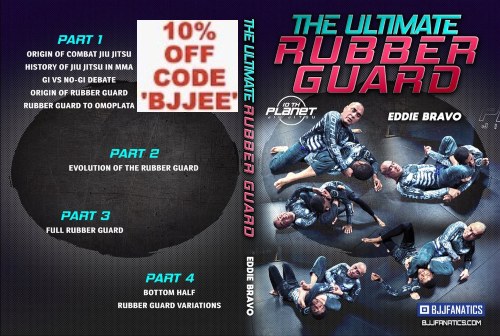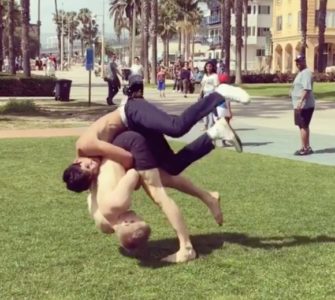Guest post by Evolve MMA, Asia’s premier championship brand for martial arts. It has the most number of World Champions on the planet. Named as the #1 ranked martial arts organization in Asia by CNN, Yahoo! Sports, FOX Sports, Evolve MMA is the best Singapore BJJ gym.
The Rubber Guard is a closed guard system, developed by 10th Planet Jiu Jitsu founder, Eddie Bravo. The Rubber Guard focuses on clinching your opponent and keeping them guessing what you are trying to attack them with. Although the Rubber Guard was developed with Mixed Martial Arts(MMA) in mind, it can be used by practitioners of Gi Jiu-Jitsu, No-Gi Jiu-Jitsu, and MMA. The submission names or technique steps of the Rubber Guard system can be quite entertaining – New York, Home Alone, Death from Below, Zombie, Chill Dog, Gogoplata, Loco Plata, and Crackhead Control. Heck, even the name of the system, Rubber Guard, often gets chuckles from people. In the end, the naming was selected to help the practitioner visualize the techniques and so that they can be committed them to memory. As with any system, the Rubber Guard is constantly being refined and developed further by practitioners throughout the world.
Why You Should Learn The Rubber Guard
In Brazilian Jiu-Jitsu, there is nothing wrong with the traditional closed guard. You have sweeps, kimuras, guillotines, armbars, triangles, and chokes at your disposal. The pitfall, however, is that if your opponent knows this is all you have to attack them with, your attacks and setups begin to become telegraphed. Your game begins to get shut down. For Jiu-Jitsu, this would be fine. Both you and your opponent will have come to a stalemate.
Introducing Strikes In The Closed Guard
When strikes are involved, as in MMA, the guard no longer becomes a 50-50 position. Now the person in your closed guard is able to strike you with punches and elbows to your head and body.
If you have ever watched MMA, if one opponent has another in their guard, they are usually getting pounded on, while hopefully trying to land a submission.
You are faced with a few choices when you have an opponent in your guard:
1) Cover up and wait for the referee to stop the fight.
2) Choose to attack with what you know- armbars, triangles, kimuras, etc. Should you try to trade blows with your opponent, you may be in a bad position, no pun intended. Your opponent has gravity on his or her side, as well as the ability to wind up their hips to increase the force of their strikes.
When you’re on your back, your ability to deliver an effective blow becomes seriously handicapped.
3) Open your closed guard and try to escape back up to your feet. The problem is, if your opponent is aggressive, he may not let you get away.
4) Break your opponent’s posture and attack using the Rubber Guard. Even getting to Mission Control, at least you’ll be able to hold your opponent at bay and deliver strikes via punches or elbows.
By getting your opponent’s hand to the mat, you’ll have effectively taken one of your opponent’s arms out the equation. So they will try to punch you with the other arm, but those strikes become telegraphed, not to mention your opponent will be opening themselves up to submissions in the process of winding up their strike.
When Rubber Guard is used, no longer will your opponent want to stay in your guard, as it now becomes a bad idea to stick around. If your Rubber Guard game is really good, a victory by submission is highly likely for you.
Rubber Guard – The Steps to a Common Submission: Gogoplata
1) Close the distance on your opponent and get to closed guard.
2) Break your opponent’s posture.
3) Get to Mission Control, by pulling one of your legs up your opponent’s back, keeping their posture at bay.
4) Get the opponent’s hand to the mat. This position is called New York.
5) Clear the neck and reconnect the leg to get to Chill Dog position.
6) Lift your leg over the opponent’s head and secure the Gogoplata. Finish either by cranking the opponent’s neck or applying pressure to the opponent’s throat.
Learning the Rubber Guard
As the Rubber Guard is practiced by Jiu-Jitsu players around the world, you should be able to find someone to practice and get reps in with. Before you know it, you’ll be a master of the Rubber Guard, blocking your opponents strikes, or simply using the clinch-based guard attack to pull off new and different submissions. You may very well find yourself contributing to the system as you provide feedback on what works and what does not. Many times, one will see contributions to the Rubber Guard system from famous practitioners, or other creative Jiu-Jitsu practitioners.
Learn The Ultimate Rubber Guard System – In It’s Newest Updated Form From Its Inventor, The Most Unique Thinker in Grappling, Eddie Bravo
- The rubber guard, a closed guard variation that helps protect you better in MMA or self defense, is so powerful that Eddie and his students have used it in elite Brazilian Jiu-Jitsu and MMA competitions.


















